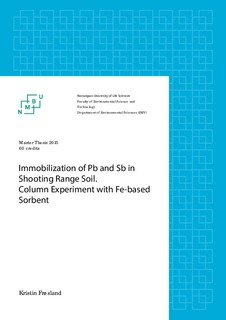| dc.description.abstract | Tons of trace metals such as lead, antimony, copper and zink, get deposited every year in
Norwegian shooting ranges (Strømseng et al. 2011). Due to the accumulation and use of
bullets and ammunition, these shooting ranges represent a potensially big environmental
hazard. Shooting range soil is most often contaminated with trace metals such as lead (Pb) and antimony (Sb). A way of immobilizing the trace metals in this kind of contaminated soil is to add an iron-based sorbent material.
The main aim of this thesis was to see if an industrial waste iron-based sorbent could
immobilize Pb and Sb from contaminated shooting-range soil. Two types of soil were
collected from two different shooting-tracks in Tittelsnes shooting range in Norway; mineral and organic soil. Column extractions were used, and the iron-sorbent was mixed into the soil
at 5 and 10 % volume, as well as added in layers of 5 %, 10 % and two times 5 %. The water extracts from the columns showed that the sorbent had a good remediation effect on Pb and Sb in both soils. Treatments with the sorbent mixed together with the soil reduced the leaching of the trace metals to some extent, but the concentration of Pb and Sb was most effectively kept back in treatments with sorbent added in a bottom layer. The treatment with sorbent was the most important parameter that controlled the leaching of the trace metals, but the sorbent also affected the geochemistry of other parameters in the lachates. As a result of treatment, the leaching of Pb and Sb were well correlated with the variation in pH, DOC and
SO42-. Another aim was to see if the sorbent would immobilize the trace metals over time. The total time of the study was 5 weeks, and water extractions were taken during the study. Statistics done showed that immobilization was effective at 5 weeks. Further studies are needed to know the long-term effect of stabilization of shooting range soil by an iron sorbent. | nb_NO |
